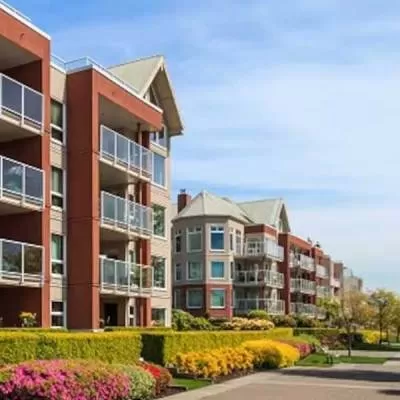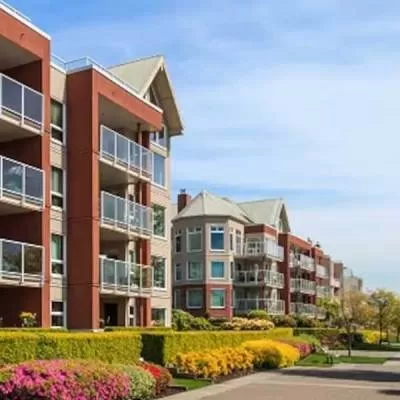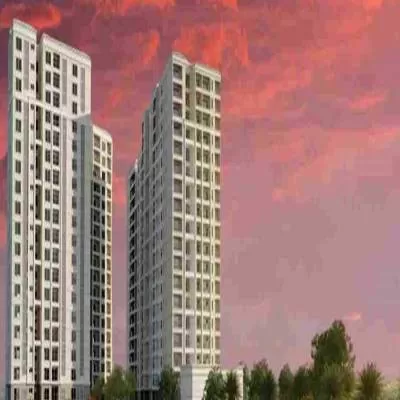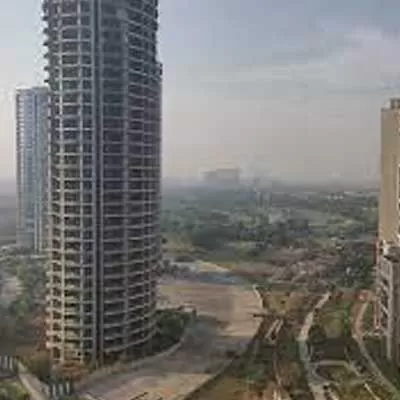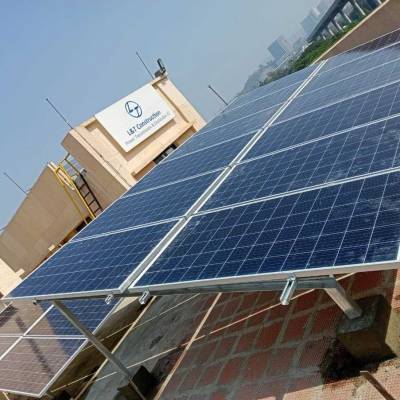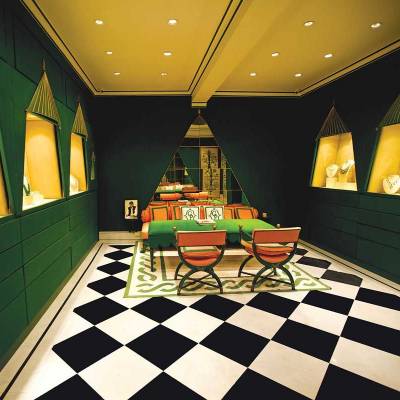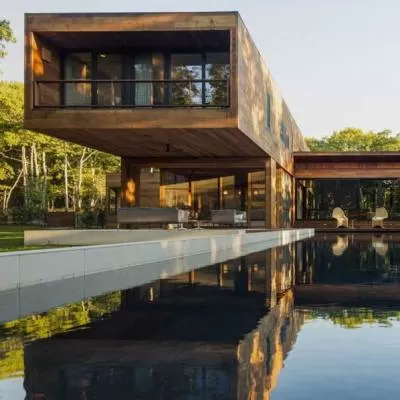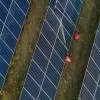- Home
- Real Estate
- With India among the world's top five countries in green construction, here are recent trends in green building materials in the country

With India among the world's top five countries in green construction, here are recent trends in green building materials in the country
With 4,205 registered green projects and a 4.63-billion-sq-ft green building footprint, India is among the world's top five countries in green construction. In fact, the country's green building footprint is expected to touch 10 billion sq ft by 2022. Greater awareness of the 30-40 per cent energy savings from a green building is the biggest driver of green construction. Green residential real estate is especially doing well, having grown its share in developing the green real-estate pie from 20-30 per cent in 2014 to 60 per cent today. <p></p> <p>Today, commercial and large residential green buildings cost 2-3 per cent over conventional construction as against 15 per cent a decade ago. The payback time for this incremental cost is about three years.</p> <p> <span style="font-weight: bold;">Glazing</span><br /> <span style="font-weight: bold;">Falling cost of double-glazing, energy-efficient glass</span><br /> Glazing has a big impact on the green rating of a building through the type and performance values of the glass used, and the extent and orientation of the glazing, which in turn depends on factors such as the building design, location and type, according to <span style="font-weight: bold;">Vikram Khanna, COO-Consumer Glass, COO- Architectural Institutional Business, CMO, CIO, Asahi India Glass.</span></p> <p>Whereas adequate glazing brings ample natural light indoors, improves human comfort levels, makes interiors look brighter and more spacious, and reduces the need for artificial lighting, the right kind of glass controls solar gain and cuts the air-conditioning need and expenditure. </p> <p>'When Ecosense energy-efficient glass from Asahi is properly used, it can cut the energy consumed by 8-10 per cent,' he adds.</p> <p>'Coated solar control glass and thermal control glass can deliver significant power savings compared to normal, non-coated, clear float glass, for roughly double the cost,' reckons Rajiv Balaggan, Sales Head-Architectural Glass India, NSG Pilkington. With the local manufacturing of green building technology and products reducing the cost of energy-efficient glass, Khanna believes this incremental cost can be recovered within the first few months of occupancy.</p> <p>Also, the growing number of green buildings has brought down the cost differential between single and double glazing by 30-40 per cent in the last decade, says Srinivas S, Deputy Executive Director, IGBC Accredited Professional, Confederation of Indian Industry. 'Today, double glazed glass typically costs Rs 300-400 per sq ft.'</p> <p>Double glazing is the norm for green buildings in India; triple glazing has yet to take off here owing to the incremental cost, observes Srinivas. Few green buildings that don't need air-conditioning or are built in places with a favourable climate still manage with single-pane glass. </p> <p>Cost-wise, single, double and triple-glaze units vary on the performance (quality) of the glass used, says Balaggan. 'Assuming similar glass is used in all the units, the basic price of double glazing would be twice that of single glazing, and triple glazing would be thrice that of single glazing.'</p> <p> <span style="font-weight: bold;">Lighting<br /> The mainstay: LED, solar energy, controls, sensors </span><br /> Through the IGBC rating programme, buildings can achieve overall 20-30 per cent energy savings. Lighting points are available on energy metering and management, tapping renewable energy on site, harvesting natural daylight through a passive architectural design strategy that cuts lighting and HVAC expenses, and using energy-saving lighting solutions like LED lighting, the preferred lighting fixture for newly certified green buildings as well as for existing buildings through retrofits, observes <span style="font-weight: bold;">Anil Bhasin, Senior Vice President-Lighting Division, Havells.</span></p> <p>A McKinsey report estimates that LED lighting will corner 60 per cent of the global lighting market by 2020 by bagging 70 per cent of the lighting solutions segment for new installations and 53 per cent of the retrofit lighting segment, he adds.</p> <p>Interestingly, Bhasin notes that the upfront cost of indoor LED lighting is almost on a par with the cost of conventional lighting technologies. However, outdoor LED lighting fixtures can cost 30-40 per cent higher on account of the material cost, high wattages, high specification drivers, protection ratings, etc. All LED lighting is associated with lower energy consumption and a longer service life.</p> <p>With the cost of installing solar panels falling to Rs 60,000 to Rs 80,000 per kW, solar energy is gaining ground, especially for meeting lighting needs, says Srinivas S, Deputy Executive Director, IGBC Accredited Professional, Confederation of Indian Industry. A residential project in Chennai (SSM Nagar Housing Complex) working towards Platinum IGBC certification with 2,952 dwelling units across an approximate built-up area of 272,972 sq m is meeting 23 per cent of its total annual energy requirement (19,651 MWh) from solar energy.</p> <p>To get the most out of solar panels and batteries, Bhasin advocates using energy management systems that monitor a building's energy usage, and automating lighting, power and HVAC systems to optimise energy savings.</p> <p>Lighting controls help save energy and provide the right amount of light for everything. Bhasin expects the Internet of Things (IoT) technology to really shift the paradigm of the electrical industry and deliver space optimisation, energy saving and productivity enhancement benefits. 'IoT involves the use of system sensors to save energy and maximise the use of spatial resources like a conference room by tracking occupancy and issuing alerts when it is vacant, to signal an HVAC shutdown and encourage re-allotment of the room,' he explains.</p> <p> <span style="font-weight: bold;">Paints<br /> Low-VOC vs zero-VOC</span><br /> During audits, Juzer Kothari, Managing Director, Conserve Consultants, Chennai, says his teams have noticed that the indoor air quality is two to four times more polluted than outdoor air, with toxic paints playing a major polluting effect, especially in air-conditioned zones. </p> <p>Paint toxicity is identified through volatile organic compounds (VOC), unstable, carbon-containing compounds that readily vaporise into the air as paint dries, where they react with other elements to produce polluting and health-damaging fumes. Indoor VOC levels are routinely 10 times higher than outdoor levels, and up to 1,000 times higher immediately after painting, says Mala Singh, Chairperson & Managing Director, PEC Greening India.</p> <p>With the VOC content in a low-VOC paint being less than 50 gm per litre VOC as against 250 to 800 gm per litre VOC in normal paints, low-VOC paint is an integral feature of green buildings, says Kothari. 'Technological advances in this area are striking. Coatings that break down toxins (anti formaldehyde) and are antibacterial along with good wash-ability are fast picking up in the market.'</p> <p>Singh believes the cost differential between most low-VOC paints and conventional paints is negligible. However, zero-VOC paints with 5 gm per litre or fewer VOCs are typically more expensive than low VOC.</p> <p>'At Kansai Nerolac, we have converted our entire range of interior and exterior paints to low VOC, with the cost remaining comparable with regular paints,' says <span style="font-weight: bold;">Anuj Jain, Director-Decorative and Industrial Sales & Marketing, Kansai Nerolac Paints.</span> 'We also offer zero-VOC paints, Impressions Eco Clean for interiors, and Excel Total for exteriors.'</p> <p>'To evaluate paint, look out for the Greenpro rating certification,' Singh suggests. 'Renowned suppliers of low or zero-VOC paints include Berger Paints, Asian Paints, British Paints, Nerolac Emulsion, Nippon Paints, etc.'</p> <p> <span style="font-weight: bold;">HVAC<br /> 150 per cent efficiency enhancement in the last decade</span><br /> Today, HVAC systems are significantly more efficient than those in vogue a decade ago. A good indicator of the efficiency-enhancement in air-conditioning is the built-up area serviced per tonne of refrigeration, which today stands at 600-800 sq ft as against 450 sq ft a decade ago, says <span style="font-weight: bold;">Srinivas S, Deputy Executive Director, IGBC Accredited Professional, Confederation of Indian Industry.</span></p> <p> <span style="font-weight: bold;">What's driving this improvement?</span><br /> Software that projects a building's lifetime energy use and helps select the most energy-efficient and cost-saving HVAC system based on other cooling materials used like reflective roofing has played a role in improving HVAC efficiency, says <span style="font-weight: bold;">Mala Singh, Chairperson & Managing Director, PEC Greening India.</span></p> <p>'Better building design as well as technology advancements such as the development of high-efficiency screw compressors, centrifugal compressors with variable frequency drives and VRF systems have helped enhance efficiency,' says Srinivas. 'With such advancements, today air-conditioners are operating at 0.6 to 0.8 kW per tonne of refrigeration as against 1.2 kW per tonne a decade ago.'</p> <p>'Godrej's green AC costs 20 per cent less to operate than a normal five-star AC,' says Anup Bhargava, Product Group Head (Air-Conditioners), Godrej Appliances. Godrej NXW, a five-star inverter AC with a rating of 5.8 ISEER (Indian Seasonal Energy Efficiency Ratio), consumes just 474 units of electricity annually in 1,600 running hours versus 1,056 units consumed by a three-star inverter AC for the same time.Operational cost savings make up for the product's higher cost.</p> <p>'Godrej uses R290 refrigerant in its Godrej NXW ACs, an environment-friendly (zero ozone depletion potential and lowest on global warming potential), highly energy-efficient gas that makes green ACs greener,' explains Bhargava. 'With this, the futuristic NXW AC complies with both the five-star requirements of prevailing BEE energy-rating norms as well as the five-star requirements of the proposed BEE energy table of 2019.'</p> <p>A cost-effective innovation in HVAC is thermally driven chillers that use solar energy and, when that runs short, natural gas to drive a double-effect chiller, says Singh. Also, geothermal heat pumps that make use of heat from the earth are said to be four times more efficient than traditional HVAC systems, she adds. 'Their piping loops underground, allowing the fluid to absorb heat from the earth, which is carried back indoors to provide heating or to drive cooling.'</p> <p>Popular HVAC product vendors include Sterling Wilson, Carrier, Trane, York, etc, while Ciat, Carrier, Climate Master, etc, offer geothermal heat pumps, according to Singh.</p> <p> <span style="font-weight: bold;">Insulation<br /> Coatings that perform as well as reflective tiles</span><br /> Coating are fast overtaking traditional insulation materials such as rock, glass wool, slag wool, extruded polystyrene foam, polyurethane foam, and so on, observes <span style="font-weight: bold;">Juzer Kothari, Managing Director, Conserve Consultants, Chennai. </span></p> <p>The availability, cost benefit and ease of application of thermal reflective paints makes them an easy-to-use alternative, according to him. 'Manufacturers, especially in the nanotechnology domain, are working on a combination of insulation and reflective properties that could completely tilt the scale towards such coatings.' Regular buildings in India can make do with coatings with reflective properties unlike buildings in the Middle East, which need coatings with both reflective and a little thicker insulation properties. A competitor product of reflective coatings is reflective tiles.</p> <p>'Whereas both coatings and tiles typically reduce the surface temperature of a building by 10-20oC, the reduction in indoor temperature can vary from 3-8oC depending on the product used,' says <span style="font-weight: bold;">Vidhyaprakash MR, Director, Excel Coatings. </span>'Our coatings with reflective and insulation properties can perform on par with tiles in reducing the indoor temperature. Our coatings, which include some nanoparticles based on weather conditions in India, additionally have waterproofing properties.' Insulation product prices vary according to performance and longevity. 'Our fastest-moving reflective coating costs about a third of our reflective tiles, Rs 14-15 per sq ft versus Rs 45-50 per sq ft,' says Vidhyaprakash. 'But the coating lasts only five to seven years as against the tiles that last the life of the building. Our coatings that last seven to 10 years cost Rs 18-20 per sq ft, which is still lower than the market average, Rs 35-40 per sq ft for a multipurpose coating.'</p> <p>In the price-sensitive Indian market, Vidhyaprakash says reflective tiles find greater application in building projects with a bigger budget, mostly in domestic real estate.</p> <p> <span style="font-weight: bold;">Building blocks<br /> AAC and fly-ash the choice of 60-70 per cent of green developments</span><br /> Roughly 60-70 per cent of upcoming green buildings are making use of autoclaved aerated concrete (AAC) blocks or fly-ash blocks instead of burnt bricks, estimates Srinivas S, Deputy Executive Director, IGBC Accredited Professional, Confederation of Indian Industry.</p> <p>In doing so, <span style="font-weight: bold;">Mala Singh, Chairperson & Managing Director, PEC Greening India, </span>reckons they will create 30 per cent less environmental waste than traditional construction blocks, and cut their greenhouse gas emissions by half.</p> <p>Basic building blocks can vary significantly in their heat transfer coefficient. For instance, the overall heat transfer coefficient of AAC blocks is 0.67 W per sq m K compared to 1.95 W per sq m K for burnt bricks.</p> <p>Also, AAC blocks are long lasting for withstanding harsh or extreme climates, and offer superior fire resistance and better ventilation. Singh feels AAC blocks are well suited for urban areas where high temperature variations are generally observed owing to the albedo effect as these eliminate the need for separate insulation, leading to faster construction and cost savings.</p> <p>Aerated fly-ash bricks, made to BIS standards, possess better insulating properties than normal clay bricks, with simulation results showing that they can cut the cooling requirement by about 5-10 per cent, says <span style="font-weight: bold;">Juzer Kothari, Managing Director, Conserve Consultants, Chennai.</span> 'Besides obvious advantages - light weight, uniformity, better compressive strength and sound insulation - the making of aerated fly-ash bricks consumes 1/8th of the energy, leading to an enormous savings in CO2 emission.' </p> <p>Additionally, consuming fly-ash bricks could save a lot of India's green cover. 'Construction in India is estimated to consume 200 billion bricks annually, the equivalent of over 800 million tonnes of clay, which erodes 66,000 acre of surface soil,' says Kothari.</p> <p>The 15-20 per cent incremental cost arising from using AAC blocks or fly-ash blocks is recoverable in two to three years, as per Srinivas.</p> <p> <span style="font-weight: bold;">- Charu Bahri</span></p>



